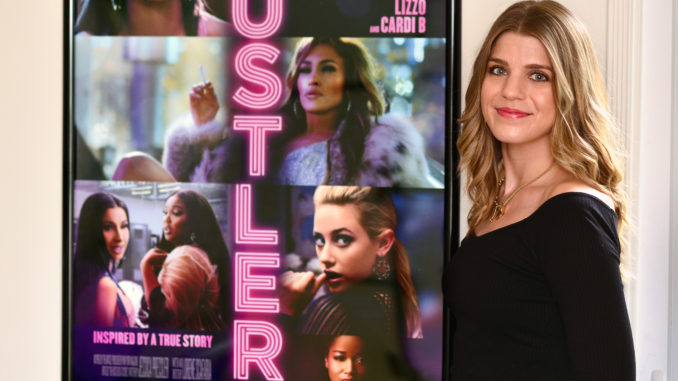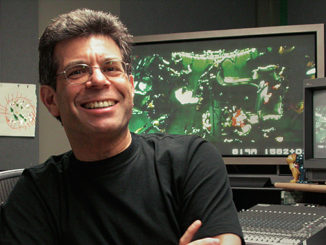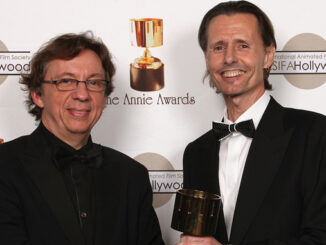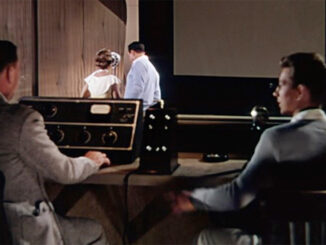
by Scott Collins
One of the year’s best-reviewed movies is “Hustlers,” an adaptation of a magazine story about a team of female strippers who during the Great Recession devise a scheme to drug and fleece Wall Street bankers.
Slate called it “an immediate entrant into the pantheon of female friendship movies,” centered around the close and complicated relationship between veteran stripper Ramona (Jennifer Lopez) and her young disciple Destiny (Constance Wu).
Picture editor and Guild member Kayla Emter gave CineMontage a backstage look at one of the year’s most remarkable films.
How did you get involved with “Hustlers?” What did you think when you first read the script?
Lorene and I have collaborated on her last two projects, “The Meddler” and a pilot for Hulu (that, unfortunately, didn’t get picked up), and I was excited to work with her on this as well. We started talking about “Hustlers” in early 2017, when she sent me the first draft of the script. I loved it. It changed a lot over the following two years, but it always had the base theme of love and friendship that hooked me and made me want to invest in these women.
Lorene has an exceptional talent telling stories in a grounded, heartfelt, clever, funny, empathetic, and emotionally motivated way. “Hustlers” was no different. She painted a fuller picture of human beings doing the best they can in a broken system. And those humans happen to be women and happen to be strippers.
I also realized this wasn’t just a great story, but an editor’s dream! A layered, heartfelt story with an incredible cast, montages around every corner, non-linear structure, voice-over, and bold sound choices, all were furthering the storyline in an interesting direction.
Was Lorene in the editing room a lot? What was your interaction like?
Oh, yes! We spent a lot of long days together during our very short post schedule. She only had eight weeks for her director’s cut, and three weeks after that to preview and lock picture. So there was a lot to tackle in a short amount of time. We also had to balance breaking away from the edit to meet with our other creative departments to discuss direction, since they also had a condensed schedule. Liz Corbett, our incredible Post Supervisor, led the way managing those outside demands to keep the post train moving, while still creating a space for Lorene and me to stay focused on the edit as much as possible. We couldn’t have made our deadlines without her, truly.
Lorene and I also utilized holidays and weekends for uninterrupted editing time. Those quiet days gave us a chance to really settle in and focus on the story. They were the best. We were doing our favorite thing, on a movie that we loved dearly.
What was process like leading up to your assembly?
Because the script was so rich and complex, I knew the assembly would be the same. So I leaned heavily on time management, organization, and a stellar editorial staff to achieve a solid assembly, on time, while still managing to have just enough energy to turnaround and dive right back in.
Despite the workload, it was a very positive assembly experience. I looked forward to watching dailies every day, which doesn’t always happen. They were so visually exciting and engaging. I would get so caught up in the humor of a scene, or Jennifer and Constance’s performances, that I’d have to start the takes over to watch again. I spent time pulling careful selects because there were so many great, nuanced moments I didn’t want to get lost in a fast turnaround.
Another significant layer to “Hustlers” was sound. No matter how big or small the project, I feel quality sound work is important and essential to how the movie plays at every stage of the process. So I leaned heavily on my stellar assistant team, Chris Voutsinas and Helen Ma, to take the lead on the sound work for the assembly.
In addition to the standard sound clean-up pass, they also created and designed Foley for 80% of the club scenes, where music playback made the production audio unusable. They really thought outside the box to create body movement, clothes rustle, skin contact, human breaths — all of it had to be created in the Avid. It was incredible what they crafted to ground those scenes. On top of technical sound work, we also collaborated on the design elements of the film. There are several whip pans, jewelry jingles, and credit card swipes that all found their voice during the assembly. So much of that work is in the final mix.
What about after?
The week after shooting wrapped, Lorene came by the editing room to watch the assembly. We popped some popcorn, poured some wine, settled in on the couch, and watched the 2 hour and 11 minute first cut. There were stretches where we both got caught up in the story, and the emotion, and I knew we had a good base to work off of. I think we were both relieved that we were kicking off from a strong place.
Were there test screenings? If so, how did those go, and what if anything did you learn?
Yes, there were a few. While it is incredibly hard to show something you know is incomplete, we kept convincing the other it was for the best, and did take away something hugely beneficial from each screening.
During the director’s cut, we previewed for a recruited audience of 100 people, sans studio involvement. It was a screening that STX offers to their filmmakers to help the creative process. That was a new concept to us, but we took advantage of the opportunity to gauge how people would receive the film. It was such a relief when the audience used keywords such as “friendship,” “strength,” “diversity,” and “joy” to describe the film. That screening gave us the assurance we were on the right track and to stay focused and keep working it.

In addition to that, one week after the director’s cut, we had two recruited studio previews. One in Los Angeles and another two days later in Paramus, NJ. While the audiences had slightly different opinions, there was consistent feedback from both that helped clarify what needed to be addressed for the final push to picture lock.
Music is used in a very interesting way throughout the film. Can you describe the process a bit and how the music was chosen?
Most of the iconic music tracks in the film were written into the script. You can imagine my delight when I read, “Ramona turns on the RADIO: It’s Britney, bitch. ‘Gimme More’.” Lorene is really great at choosing songs that help elevate emotions and push the story forward. Starting the film with Janet Jackson’s “Control” set the tone so perfectly and emphasized Destiny’s struggle to gain control over her life and career. Fiona Apple’s “Criminal” made me fall off my chair and go to a hypnotic place with Ramona, Flo Rida’s “Club Can’t Handle Me” had me bursting into tears, and Lorde’s “Royals” said so much about what was happening on screen. I also love how Lorene leans into music from different decades and genres. Scott Walker’s “Next” was the perfect surreal fit for that sequence, and the Frankie Valli tracks feel like they were made for those scenes. All in the script.
Even with several tracks already decided, there were a couple dozen that still had to be found. Via Spotify, my assistants and I went back in time and scoured the top hits of the 2000s, slow-jam compilations, and popular strip-club songs. I don’t think my “recommended for you” playlists will ever be the same!
How exactly were the pieces chosen and what were you and Lorene going for? I’m thinking specifically of piano music used for some of the scenes in Ramona’s apartment.
I loved Lorene’s bold choice to use Chopin as the sound of the movie and to forgo traditional score. She had written those cues into the script at an early stage and chose those specific études because they require a lot of flexibility and sincerity, which is also what’s required of dancers on the pole. It was beautiful how they became the sound of the love story and romance between Destiny and Ramona.
Did you get the chance to cut any music into the final?
A lot of the music cues did make it into the final. Our Music Editor, Melissa Muik, was such a guiding light and helped us dig through dozens of alts for some of the less featured music. Those tracks also had to hold up next to the show stoppers, speak to the emotion of the scene, and stay true to the era. She also did an incredible job editing the Chopin cues, when necessary, while still protecting the integrity of the tracks and shaping it to our edit.
The movie explores in many ways the feeling of ordinary people that the system is rigged against them, especially in the wake of the Wall Street crash. That rich bankers “had it coming” to them. Was this something you and Lorene discussed during editing?
We discussed those feelings primarily during the script stage, since the idea of a story about women doing bad things made people nervous. I think Lorene did such a beautiful job painting a fuller picture about the complexity of wanting a character to succeed even if you don’t agree with what they are doing.
Did it influence choices made or not made? How so?
It didn’t influence us a ton; we used the script as a guide on the story and message we wanted to convey. At the core of the movie, it’s about friendship. So we just kept coming back to that, and it kept things focused.
What were the hardest scenes to cut?
Some of the hardest scenes to cut had the most amazing footage. Our extraordinary DP, Todd Banhazl, did such a fantastic job that everything cut together… it was the choice between so many great moments that proved to be time-consuming and offered up a lot of options during the assembly stage.
For example, the locker room scene where the girls are getting ready had so many funny, gorgeous, real moments that I wanted to incorporate, but I couldn’t possibly be on everyone at once. Same goes for the all-lady Christmas scene, which is one of my favorites. Every take was pure joy, so that was hard to choose from! It was really special shaping that sequence with beautiful moments of these women supporting and celebrating with their chosen family.
But I have to say Ramona’s pole dance was one of the hardest, and my favorite scene to edit. I took an entire day to work with the scene since there was so much incredible footage to chose from, and I knew it had to be the perfect introduction to Ramona and the powerful entrance she deserved.
Instead of pulling selects for this scene, I used the process of elimination to find the best, most impactful moments. I stacked every take, every camera, in a sequence and removed footage leaving me with a visual representation of what sections of the dance had several options and which areas needed a bit more love and crafting. From there, it was just settling in and trying several juxtapositions of shots to see what combos made my heart jump. I also let the tempo of the song, and Jennifer’s commanding controlled presence inform me of where to cut, and when to cut away.
The final layer was so important – watching Ramona through Destiny’s POV and feeling what she’s feeling. There were a few dance moves that made my jaw drop, and I used those as the opportunity to cut to Destiny and experience her reaction as well. I found it helped connect us to her and the growing love affair.
What about cutting those backroom scenes at the club, where there is a lot of repetition as we see the women “work” various men.
I have to give a lot of credit to Todd and Lorene, who designed so many of the complex sequences so brilliantly that it served as a great roadmap on what the scenes wanted to be. From there, it was just finding the right rhythm to track our characters and the scenario they are in.
The pace of those scenes is fast – did that make them hard to cut?

I loved that the film wasn’t just one thing. There are moments where we sit with our characters and absorb their world and other times where there is a burst of energy that keeps propelling us forward. The fast pace was also useful in creating a whirlwind of how things got away from these women.
One sequence that utilized contrasting pace for emotional impact is when the naked man jumps off the roof and has to be rushed to the hospital. There is a good stretch of hectic flurry chaos, which is funny because the circumstances are so heightened, but inevitably reality crashes in, and we see that actions have consequences. Todd and Lorene were right on point when they decided to shoot those moments of Destiny rushing to find her daughter and get her to school, in long, tedious oners that made you feel every … step … Destiny … takes. That contrast was so powerful in heightening the stress of the situation, that when Destiny hits rock bottom we really feel it.
What were the biggest surprises in cutting the film? What did you learn?
I learned that voice-over is not to be messed around with. It is an entire layer of the film that needs time, precision, emotional tracking, and nuance. With such a condensed schedule, that proved to be a bit daunting. Constance came in for ADR a few times as we were exploring the content and re-writing when necessary. My assistants kept things labeled and organized so Lorene and I could pull up a sequence and listen back to all the readings in one step. Without that system, I may still be sifting through voice-over!
Lorene and I also had daily reminders in the form of Post-It notes hanging about our scene card wall. One was “Money and Friendship,” which was the theme we always came back to and grounded ourselves in for the story of Destiny and Ramona. We also had “Trust the Trim” and “No Conclusions.” Those were helpful reminders to be bold.
What have you thought of the reaction to the film?
Truly blown away and so grateful. Lorene and I had so much fun editing this movie and getting it across the finish line. We were beyond exhausted, but truly happy. If at the end of the day no one saw it, I was going to have to be okay with that because I loved and believed what it stood for. So that fact that there has been so much positive reception is extremely heartwarming and quite emotional, to be honest.
I love that people are enjoying the movie and the theater experience again, but also that they walk out of the theater having felt more than they expected. Not only is it a wild ride with flash and humor, but it also touches on a lot of relatable themes of friendship, motherhood, and struggle. And hopefully, it also gives audiences a different understanding of strippers and women.
Scott Collins is Communications Director of the Motion Picture Editors Guild.





